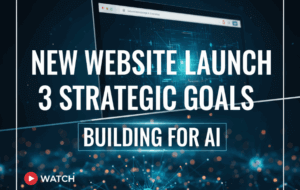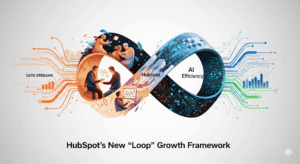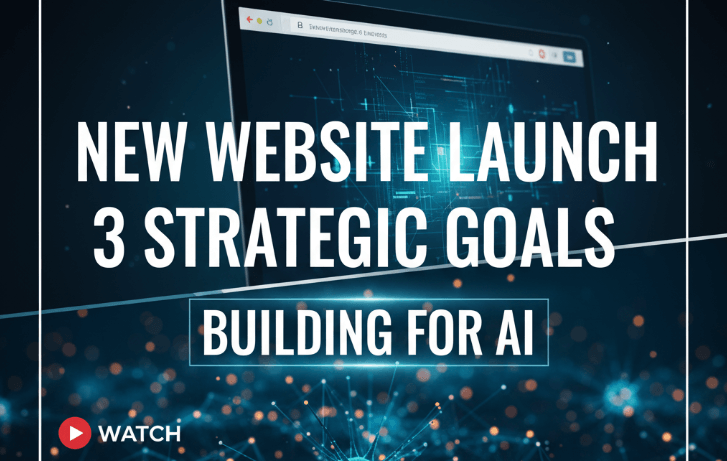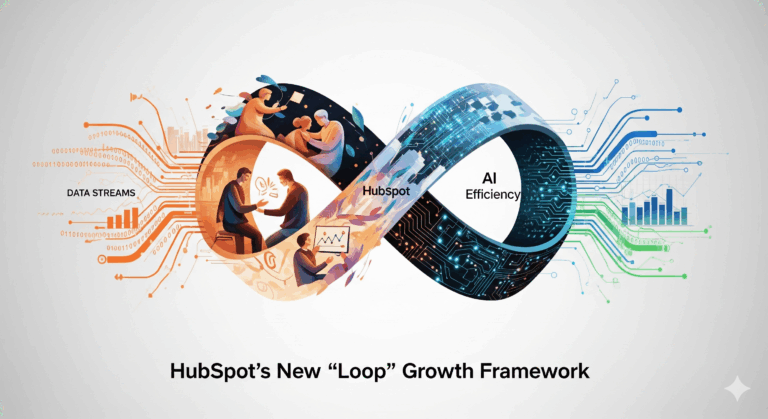For anyone who couldn’t make it to the excellent Digital Summit Series in Philadelphia, below are key points worth knowing for each of the sessions I attended. My hope is that, by reading these notes, you can benefit from my attendance. Call it the definitive guide to Digital Summit Philadelphia 2025, minus the sessions I didn’t attend (if only I had Hermione Granger’s time turner to be present at every session. Alas.).
So first up, the non-educational aspects. Here are some shots of Philadelphia as well as the convention center entrance where the event took place:

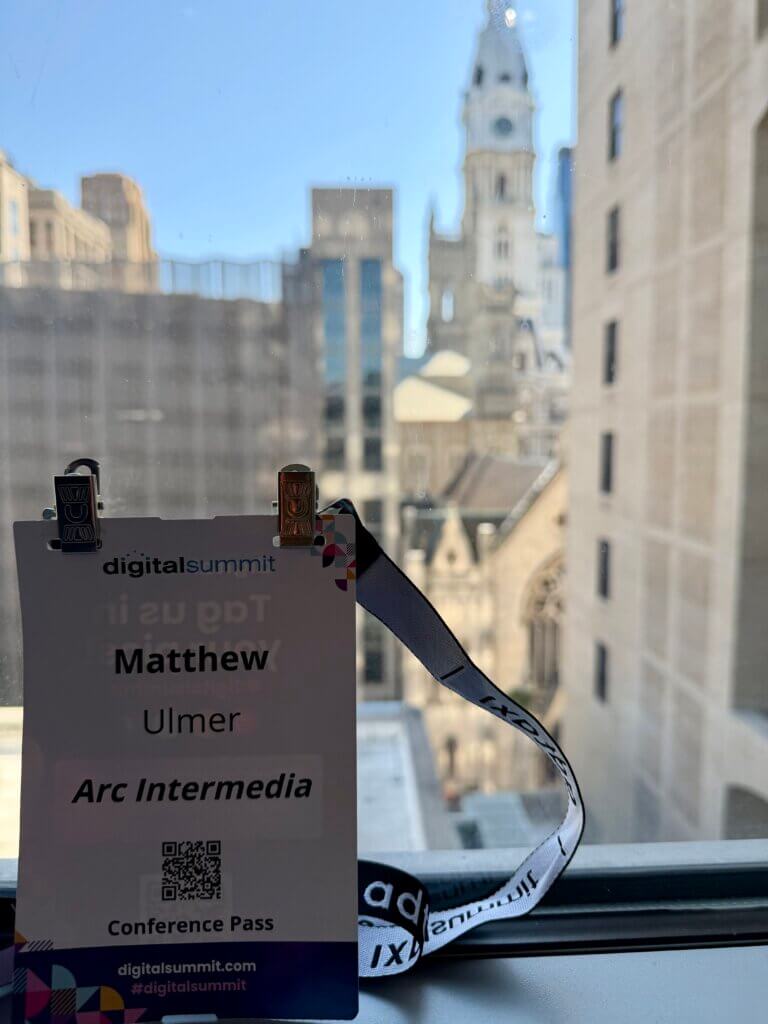

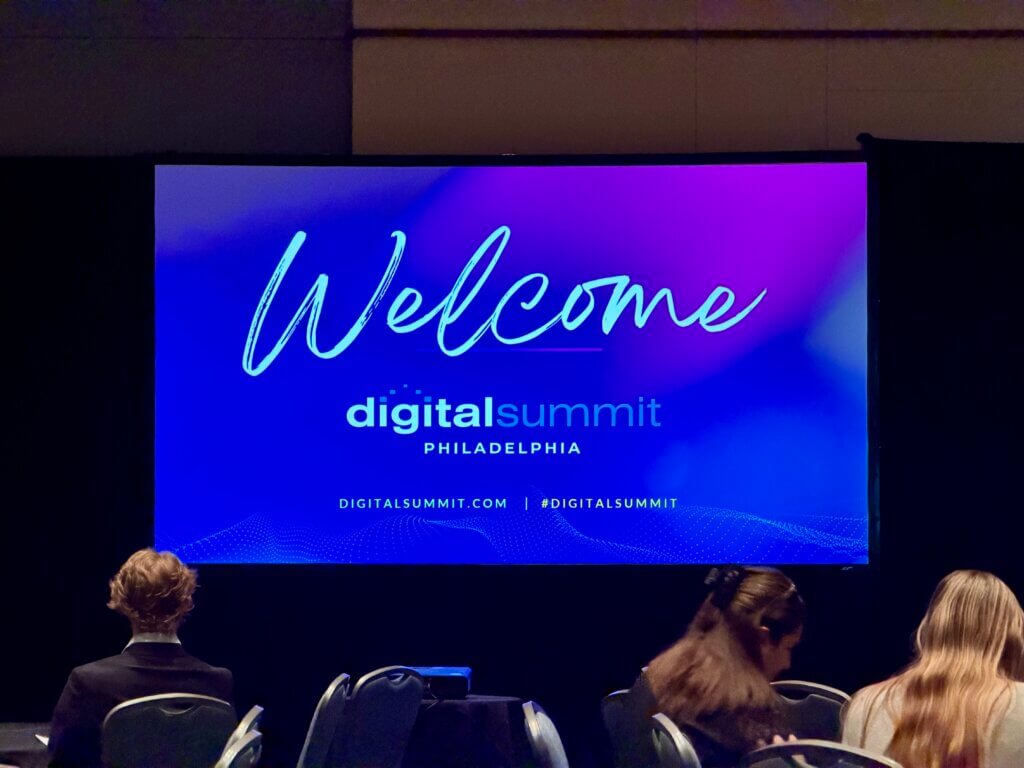
Plus, proof that I was really there:
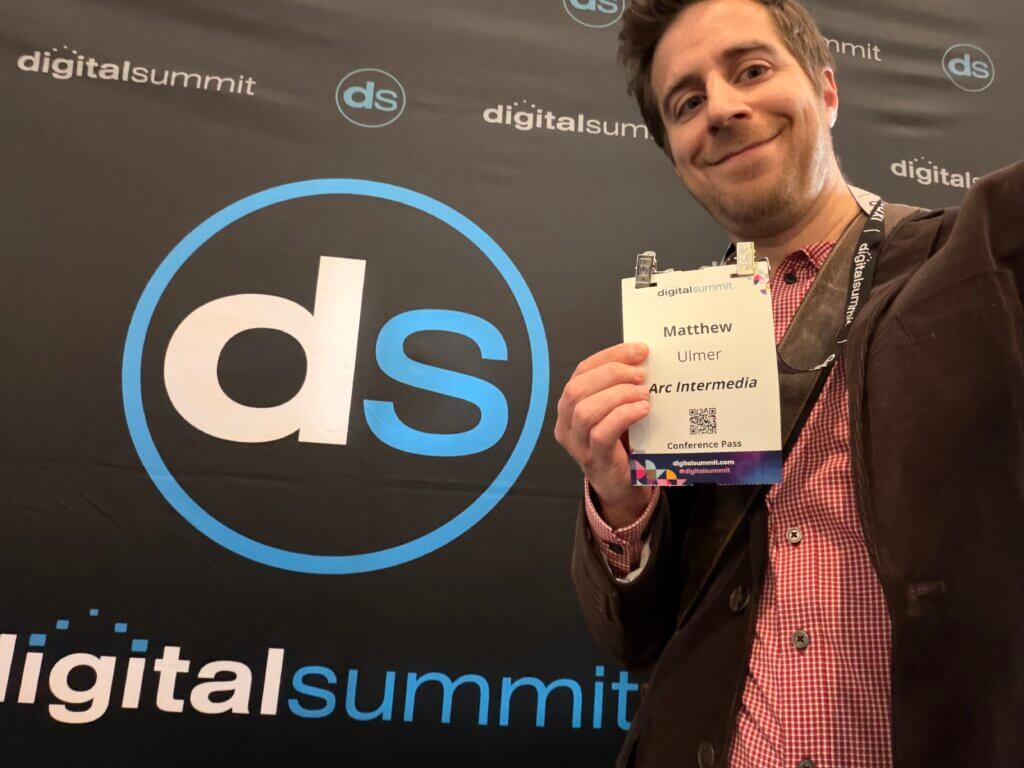
And now, onto the learnings!
How to Quit Bad Marketing and Start Generating Quality Leads
Presented by Jon-Mikel Bailey, Source Marketing Consulting
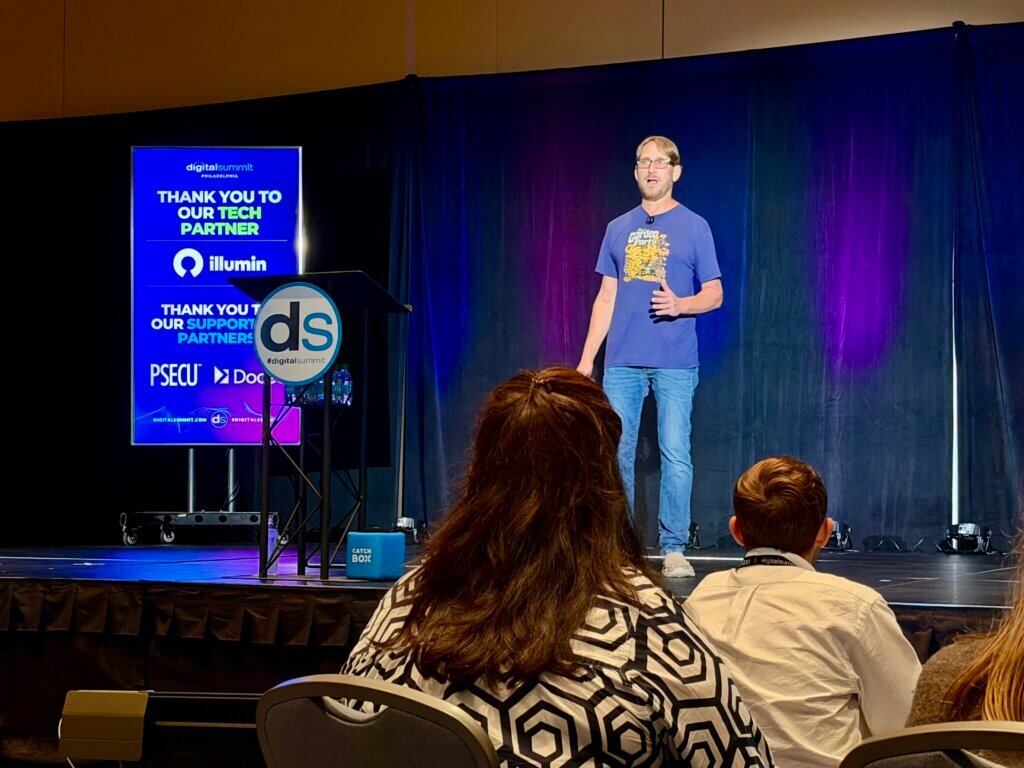
- Ignore the stats of which channels other marketers are adopting. All that matters is where your audiences are.
- 79 percent of marketing leads never convert into sales.
- 68 recent of businesses report difficultly in attracting leads.
- Critical mistakes:
- When strategy is not based on buyer market research (who, where, why)
- When you don’t conduct competitor gap analysis
- When you don’t communicate key differentiators
- When most efforts are based on guesses or trends
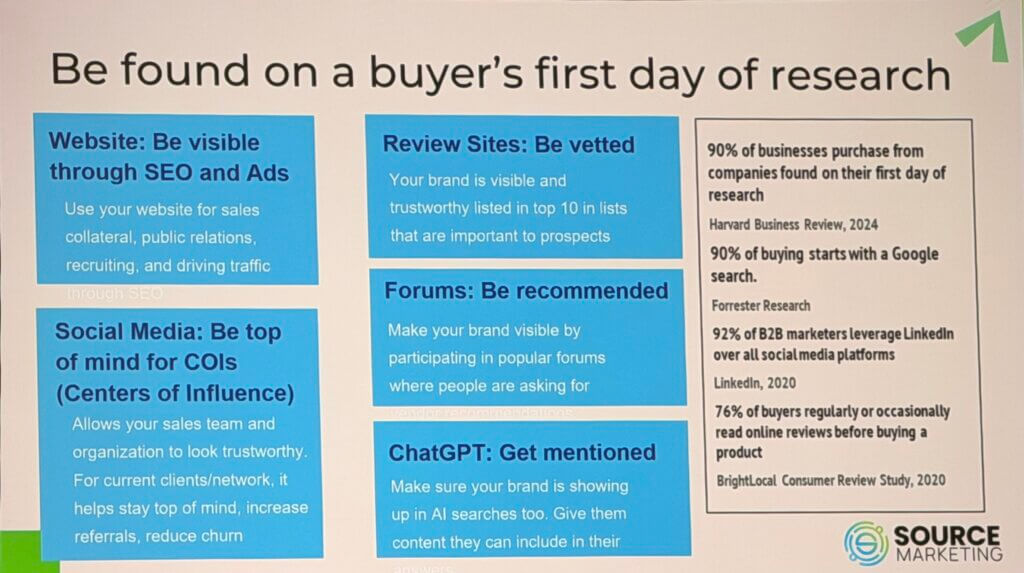 Too many agencies don’t talk strategy, don’t focus on strategy.
Too many agencies don’t talk strategy, don’t focus on strategy.- Too many agencies don’t focus on ROI.
- The key to good lead generation: meet them were they are:
- Search (standard and AI platforms)
- Directories and review sites
- Social media
- 90 percent of businesses purchase from companies found on their first day of research (Harvard Business Review).
- 92% of B2B marketers leverage LinkedIn over all social media platforms (LinkedIn).
- 76% of buyers regularly or occasionally read online reviews before buying a product (BrightLocal Consumer Review Study).
- Make sure you provide genuine, helpful insights rather than just promoting your services.
- Busywork doesn’t drive leads.
- A data-first approach ensures your marketing spend works for you, not against you.
- Strategy is not:
- Software dashboard
- Vague traffic goal
- One-month content calendar
- “AI”
- Instead, align your marketing goals with the customer journey. Focus on desired outcomes (hint: conversions and leads). I’ll take it a step beyond the presenter and say actual sales/new contracts.
- AI is not currently replacing search. So far, it is an additional marketing channel.
- Yes, that will change. But right now, it’s another channel, another opportunity.
- What strategy really is:
- Comprehensive blueprint for how you’re generating leads through your marketing efforts.
- Messaging plan that connects brand to buyer.
- Scalable model to tie tactics to revenue.
- Keyword plan tied to customer intent.
- Constant focus on data and what data means for driving leads
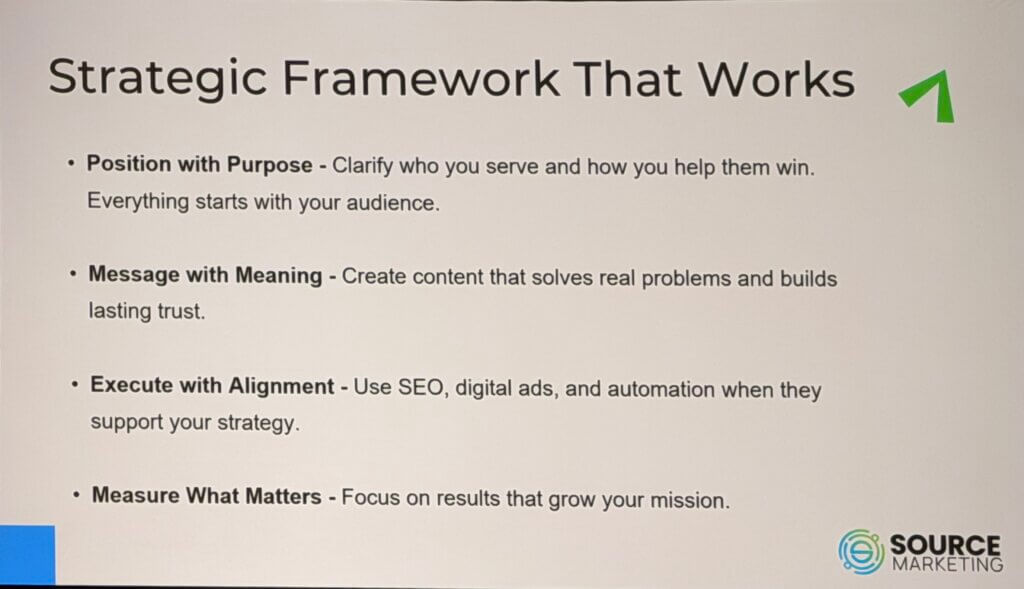 Clients need a short- and long-term strategy: quick wins like PPC and promos, plus long-term value built by trust, relevance, and search.
Clients need a short- and long-term strategy: quick wins like PPC and promos, plus long-term value built by trust, relevance, and search.- In all content, make sure the customer is portrayed as the hero, not your company/product/service. You are the guide.
- You can say “we rule” as much as you want, but no one will believe it unless you show proof.
- Companies must have a brand promise.
- Brand promise + customer experience = growth
- Focus growing your online visibility in four places:
- Website (SEO and PPC)
- Social media (targeting COIs)
- Review websites
- Forums
- When having AI write content, first tell it your differentiators and who you are targeting.
- Performance-driven strategy. Ignore everything else. You must have a performance-driven strategy. It will result in:
- Better leads
- Lower CAC
- Clearer ROI
- Scalable systems
- Good line: Turn digital chaos into predictable growth.
2025 B2B Marketing Contrarians: Revenue-Driving Strategies Your Competitors Won’t Use
Presented by Tyrone Heath, LinkedIn

- There is no good in being the consensus; you must be contrarian.
- Do what no one else is dong, and be right in it.
- First Impression Rose: Those on The Bachelor who receive a first impression rose are 4x more likely to make it to the finale.
- Is it better to leave a strong impression early on, or wait until the last minute to make a move?
- Availability hieristic — you tend to trust things that come to mind more easily; this is why the first impression rose is so effective.
- You are viewed as not just an option but a frontrunner
- If they don’t know you before Day 1, it’s already too late. Build your brand among the 95 percent from before they buy.
- 5 percent are in market, ready to buy right now. 95 percent are out of market, they are not in the running for your offering right now.
- Most of the money to be made in B2B is from future prospects.
- Lead generation is for in market buyers, prospecting is for out market buyers.
- A buyer’s first search engine is their own mind — they consider which brands they are already familiar with.
- Bold creative isn’t a risk. Not making the Day 1 list is the risk. Make a strong first impression with attentive, branded ads.
- Is it better to leave a strong impression early on, or wait until the last minute to make a move?
- Memory Mix Modeling: Marketers aren’t here to earn a click, we’re here to make memories stick. Earn attention, then make sure it sticks.
- It’s not about how many clicks it takes to drive a sale; it’s about how many memories it takes to drive a sale.
- Choose memorability over clickability.
- Attention is the best initial metric. Can be measured using dwell time.
- Even passive attention can be useful — every time a prospect sees your ad, it is building memory, even if they’re only partly paying attention. All those minor interactions add up into awareness.
- Like painting the Golden Gate Bridge, make sure you are constantly topping off awareness.
- Video is key for awareness; it captures active and passive attention.
- Just like different channels serve different media objectives, different formats serve different memory needs.
- Less than 1 percent of B2B companies feature characters in their branding, but even in B2B, characters are one of the best drivers of memorability.
- They can be animated (like Salesforce) or spokespeople.
- Salesforce brand attribution lifted 6 percent when they added Astro, their mascot.
- Von Restorff Effect: In the sea of sameness, something distinctive drastically stands out.
- 81 percent of B2B ads are drowning in a sea of sameness.
- Average percentage of ads being recognized in B2B is 19 percent.
- The Search for Similarities: don’t obsess over the differences, focus on the similarities.
- Personas create artificial divisions that make targeting and messaging complicated.
- Prospects are much more similar than you think.
- Focus on common entry points. Find all the buying sessions that are the same.
- Starbucks is the first coffee brand that comes to mind because they own the most buying situations.
- Become distinctive across multiple buying situations.
- design Big Messages for Big Segments.
- Circles of Doom: Who drives growth, sales or marketing?
- Only 16 percent of sales contacts overlap with marketing’s targets.
- Instead, cast a wide net with brand ads to drive sales lift.
- Marketing and sales must have a shared strategy, not just a shared audience.
- Hidden Buyer Gap: Sometimes we get stuck seeing only one side of the picture, instead of the duality of optical illusions.
- This often ends up becoming focusing on visible buyers. But what about all those hidden buyers?
- Close the gap. Expand your targeting, to talk to the initial contacts at a company as well as the decision makers who are the hidden buyers.
- Hidden buyers have half the decision-making influence.
- Hidden and target buyers have different purchase criteria. If you aren’t hitting both, you fall through the gap.
- You are way more likely to close if awareness is spread among the buyer group from the start.
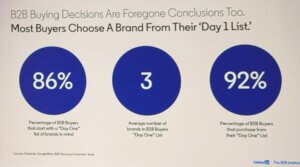
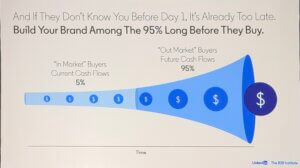
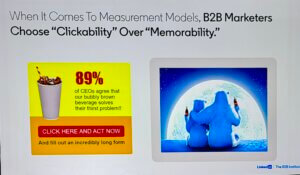
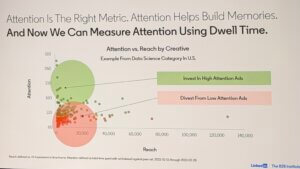
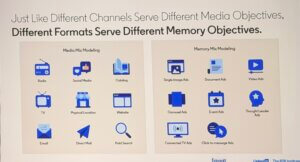
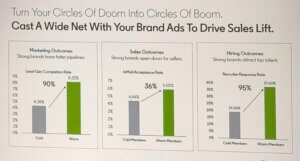
The Unexpected Playbook for Modern Executive Communication that Builds Trust: Insights from Taylor Swift, Ted Lasso, and Shonda Rhimes
Presented by Hilary Sutton, HSL Digital
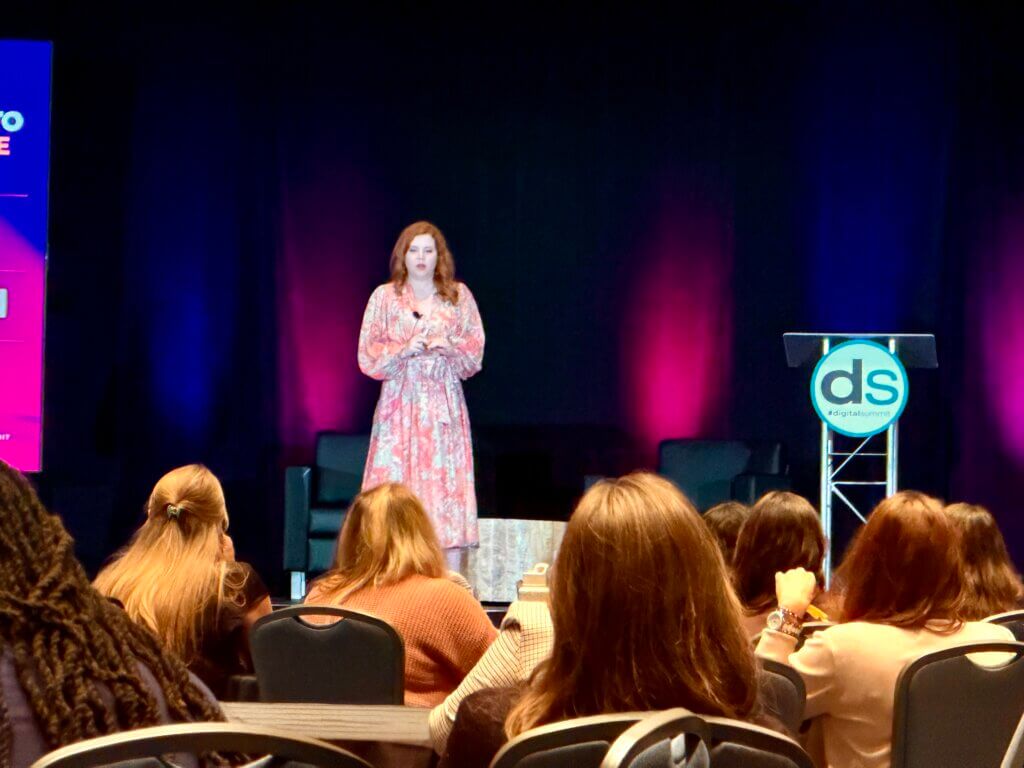
- Storytelling & Reinvention: Control the narrative by ensuring the same story is being told every where — your website, social media, forums, review sites, etc.
- You need strong emotional presence — make customers feel connected to you to build loyalty.
- The audience is the main character.
- Example 1: About her concert, Taylor Swift said “I can’t wait until we all get together to sing these songs.” She didn’t say she couldn’t wait to perform for everyone.
- Example 2: Taylor’s engagement photo kept the audience as the main character: Your English teacher and your gym teacher are getting married. We aren’t the stars in this story — you are.
- Personal brand anchors:
- What do you do?
- Who do you serve?
- What do you want people to think about when they think of you?
- Empathy in Action: Be curious, not judgmental.
- Leadership that inspires trust (not just as an employee in an organization, but as a company in an industry).
- Empathy wins every time.
- Know your audience:
- What matters to them?
- How do they expect to be engaged?
- What motivates them?
- Avoid narcissism and negativity.
- Utilize happy employees as brand evangelists (provide guidance).
- You aren’t just a marketer. You are the message architect.
- Personal brand is an evergreen asset.
- Executive visibility is a growth multiplier (get your execs on social media). Help them build a platform.
- Small, consistent steps outweigh viral one-offs.
Implementing AI into Marketing Operations
Presented by Lucas Petty, AI Daddy
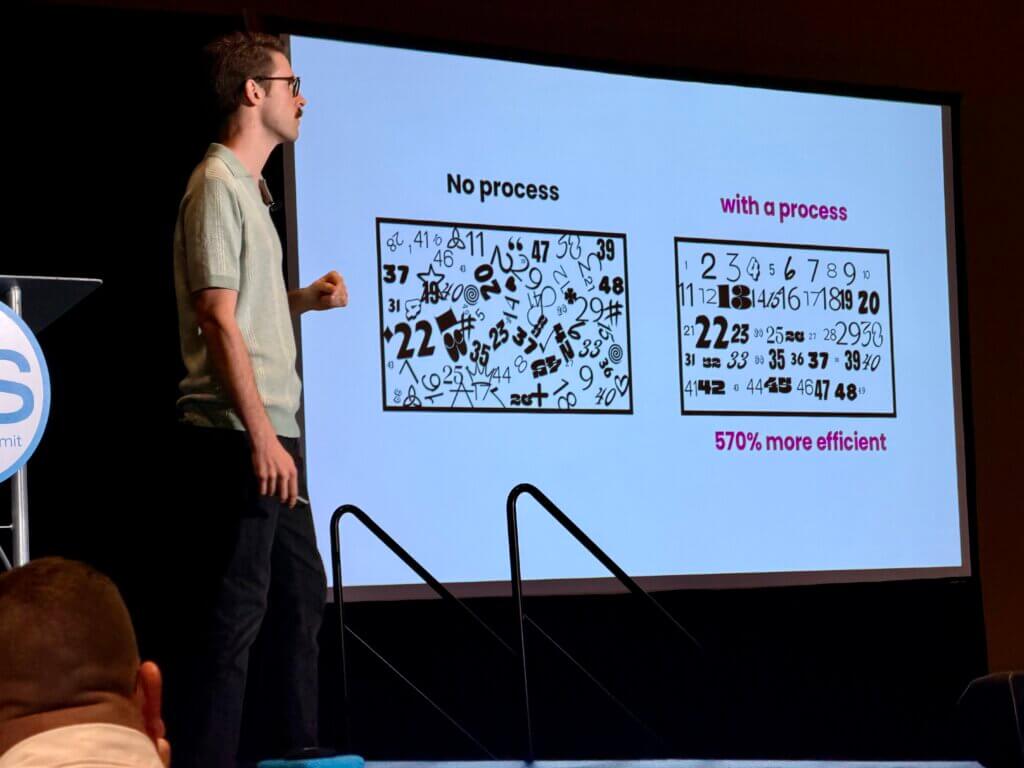
- Biggest known AI challenge is clarity on ROI.
- Biggest hidden AI challenge is lack of confidence in it.
- Industry average is 9 months to roll out AI initiatives.
- 95 percent of generative AI pilots at companies are failing.
- You can’t fix what you can’t see.
- 70 percent of AI challenges are related to people and processes. Only 30 percent are related to an actual technology issue.
- AI roadmap to guarantee ROI:
- Pick a one year goal for your process (don’t go longer than that, because of how fast AI is changing).
- Pick processes and a team.
- Map your processes (think like the layout of a HubSpot workflow).
- Identify recurring pain points/problems in the business.
- Really, this is identifying constraints in the business.
- Research AI based on everything you just reviewed.
- Implement.
- Every business problem is a communications problem. Every communications problem is a process problem.
- Rolling out AI is the same principle as any other process you’ve rolled out before. Don’t get distracted by the notion of it being AI.
- Horizontal AI = AI tools (like ChatGPT, for productivity)
- Vertical AI = AI automation/agents (combining AI tools with your existing processes, for ROI)
- AI voiceovers in ads increase conversion by 5-10 percent.
- 100-140 WPM is the average person.
- 150-160 WPM is best for learning and selling.
- This is the speed we learn from and pay attention to the best.
- No ums and uhs; much clearer and at the peak speed.
- Every company should have an AI policy that defines the why of AI (what is the AI expected to accomplish for the company, why are we rolling it out?).
- Those who write the plan don’t fight the plan. This is why it’s essential to have team members be part of mapping out the process. Get them to feel invested in it.
- Interesting phenomenon in AI: When it tends to look real, people don’t trust it (“is this AI?”), but when it’s so obviously unreal (like a baby fighting a panda), we don’t have to wonder if it’s real or AI and can simply enjoy it.
- CEO of AI Daddy says no one in attendance is at risk of AI taking their jobs; he notes that companies that cut staff and go full AI tend to reverse course six or so months later, hiring back humans.
AI-Driven Strategies for Engaging the “Predictably Unpredictable” Consumer
Presented by Michael Burke, Google
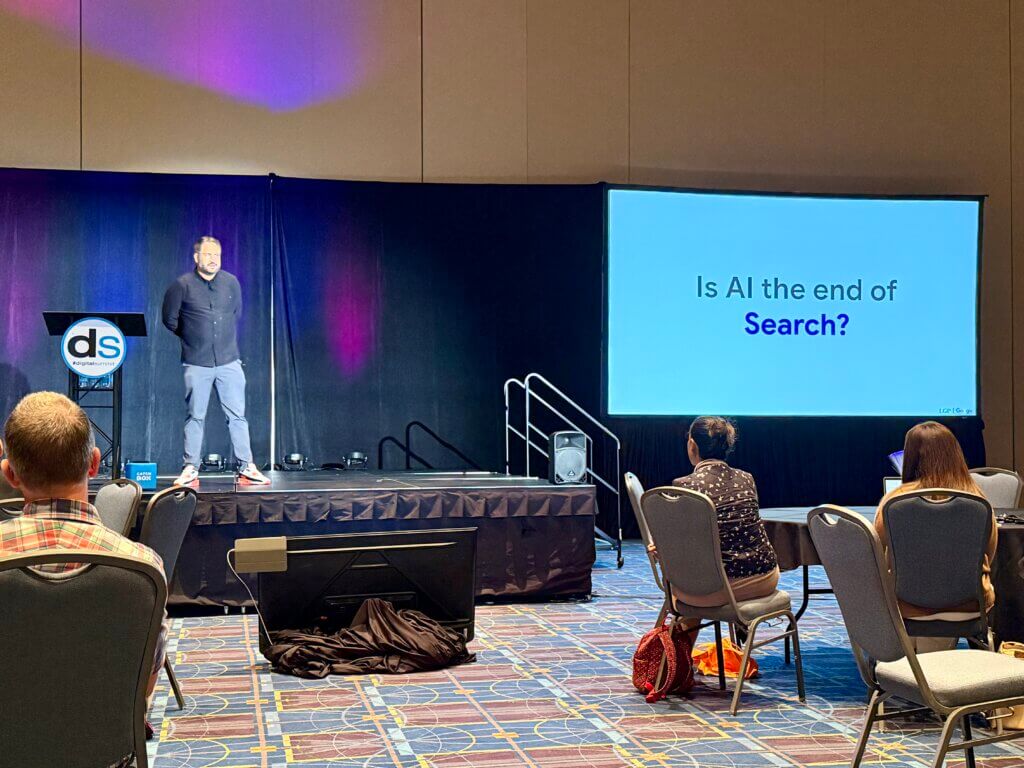
- The way this Google employee prompts Gemini is to make definitive statements, to instruct it as if describing something that already exists.
- Example: “Use this image to create a graphic of a figurine. The figurine is placed on a computer desk. The figurine has a round transparent acrylic base, with no text on the base. The content on the computer screen is a 3D modeling process of this figuring. Next to the computer screen is a toy packaging box, designed in a style reminiscent of high-quality collective figures, printed with original artwork The packing features two-dimensional flat illustrations.
- Multi-model prompting is getting more popular on Google, such as sharing an image along with a text prompt.
- “Ads are the most valuable information at the time we need it.” – Larry Ellison
- There is an amalgomous connection between SEO and GEO, but they ultimately need to do different things.
- GEO is not susceptible to the same “tricks” employed for SEO.
- GEO comes down to being a good company that creates content people want.
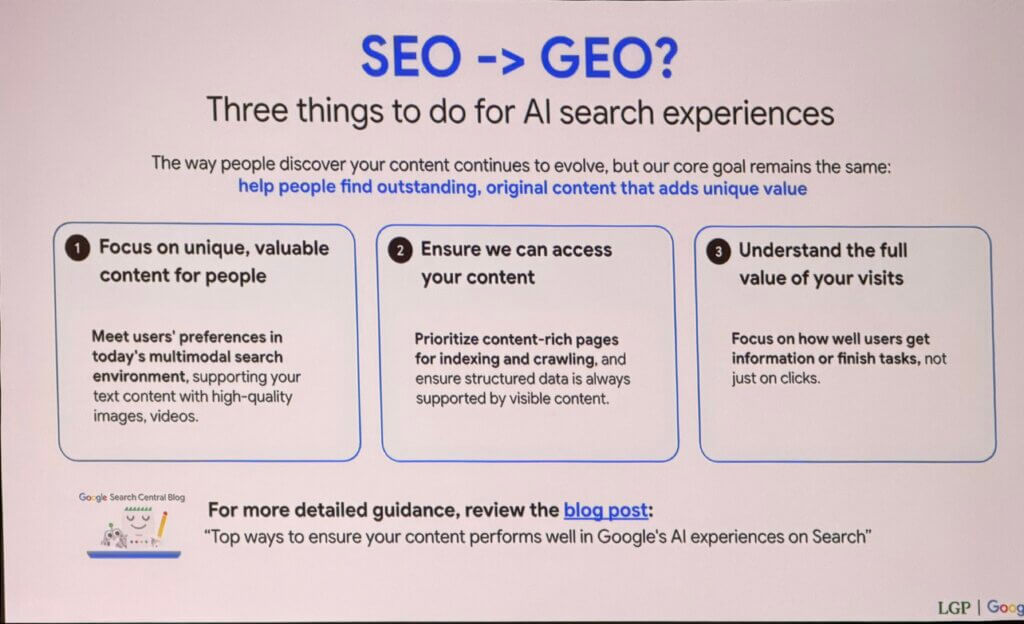 GEO is really a content-fed practice.
GEO is really a content-fed practice.- Video is particularly powerful for GEO.
- He has been listening in on the discussions of how to get your company to appear in an AI answer. He notes SEO agencies are becoming something more akin to PR agencies.
- He claims Google + YouTube delivers 21 percent higher RoAS than any other media (source: “Google conclusion”).
- Measurement: What’s old is new again. We’re back to less specific metrics.
- There’s no longer a single form of truth.
- Stop chasing visits, clicks, etc. Focus more on increases in brand searches, etc.
- Based on Google macro studies, investing 8-20+ percent on demand gen atop always on search/PMax/shopping sees:
- -4 percent account-level CPA.
- +12 percent account conversions.
- He showed off Veo 3 with several movie-quality video ads, as well as a Veo 3-created recreation of Google’s Super Bowl ad, challenging the audience to tell which one was real and which was AI.
- One of the bigger breakthroughs of this tool is more accurate rendering of products (such as a Heinz ketchup bottle).
- Google is looking to “democratize content creation.”
- The entire web will soon be shop-able, like being able to purchase the shirt someone is wearing in an Instagram video.
- Question asked: Do you think AI Mode will ever have ads? Answer: Yes.
- The AI team wants no ads.
- The sales team wants all ads.
- They want to let the users decide the best mix.
- Question: How do you stop an LLM from sharing negative information about your company? Answer: Hire a GEO agency. OR on your own do a bunch of queries to pinpoint the source of the information, and see if you can influence them.
- The image shows a slide of: “Is AI the death of search?” Spoiler: No!
From Google to ChatGPT: Your Customers Are Finding Answers in New Places. Here’s How to Win on AI Search and Beyond.
Presented by Wil Reynolds, SEER Interactive
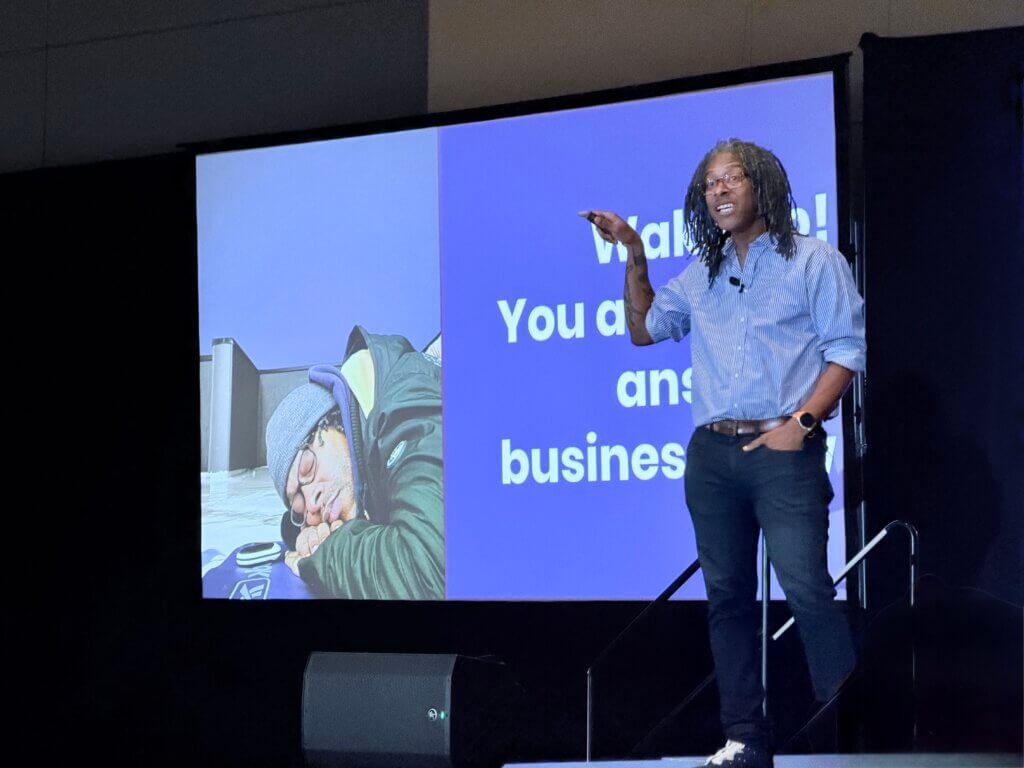
- “Wake up! You are in the answers business now.”
- Connect your analytics data to an AI tool so you can have the AI assess the data for you.
- Yep, time to update your KPIs.
- Overlay your old KPIs against your leads and revenue.
- 53 percent of consumers distrust AI-powered search results (Gartner survey).
- Wil is very adamant against the “hack” of creating your own list of best agencies.
- He presented at a financial conference seven years in a row, yet was beat in the AI platforms by the fake listicles. Buuuut are those guys earning conversions from that placement and any residual traffic? You know the answer.
- Search has made us a bunch of followers — we look at what our competitors are doing, and find at least one thing to beat them at to elevate our rank above theirs.
- How many links do you click in search results where every homepage sounds exactly the same? You must work to stand out.
- Sometimes it’s better to write great content that doesn’t rank than mediocre content that does.
- The key is that visitors must be grateful to have read your content.
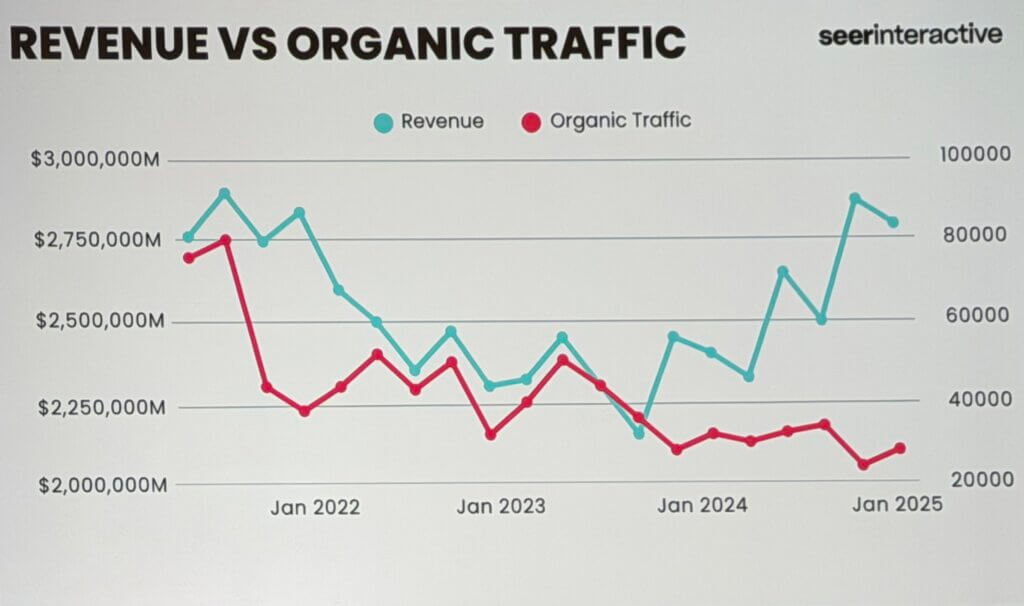 AI search platforms will win, because companies’ websites are filled with friction — they don’t provide the right answer, or they try to get you to create an account, or the cookie policy pops up or a newsletter sign-up pops up, etc. All friction that gets in the way of getting the actual answer.
AI search platforms will win, because companies’ websites are filled with friction — they don’t provide the right answer, or they try to get you to create an account, or the cookie policy pops up or a newsletter sign-up pops up, etc. All friction that gets in the way of getting the actual answer.- Interesting idea for lead forms: update it to ask people what their prompt was. Of course, there may have been multiple prompts in the process, but create a mechanism where you can follow-up with the person.
- Stop using the word “landscape.”
- “People outside the field are often surprised and alarmed to learn that we do not understand how our own AI creations work.” – Anthropic’s CEO
- Just like with SEO, which audience do you want to make content for — friends or the algorithm?
- Winning with algorithms lose with people.
- Make content that is shareable. Then you know you’ve written content that connects.
- When AI traffic does actually get traffic to your website, more conversions than ever will likely be coming from the homepage.
- A study SEER conducted confirmed there’s a strong content recency bias in LLMs.
- Don’t obsess over the traffic. Obsess over the leads. Obsess over the revenue.
- Be obsessive about creating value.
- Wil uses a tool (Phantombuster) that pulls out the profiles of every social user who liked one of his posts, then he’s able to extrapolate that into details about the person, to better customize content.
- We as marketers are going to have to stop relying on data. A painful statement for someone who made their career by promising to be able to track everything.
- Don’t worry about knowing what Google likes or ChatGPT likes. Worry about what humans like. That’s transferable to every platform.
Creating a Smarter Brand Infrastructure: The Shift Toward AI-Driven Content Management
Presented by Kelsey Fielding, MediaValet
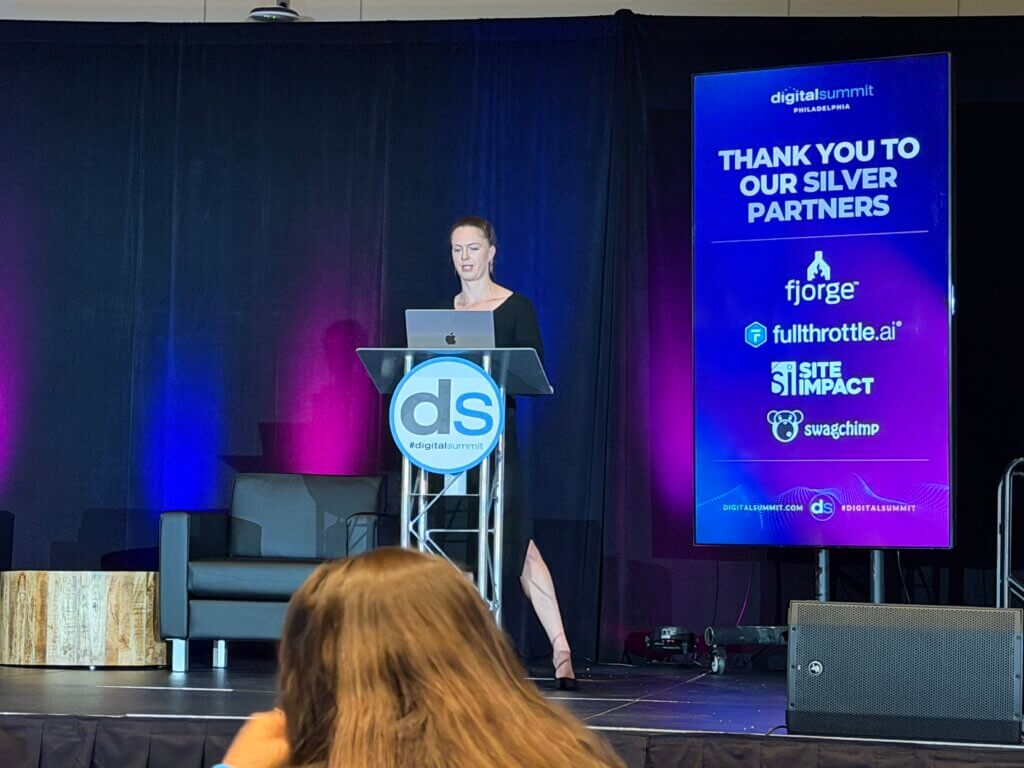
- Where’s your biggest bottleneck today? Is it:
- Finding the right asset
- Managing asset approvals
- Usage rights and compliance
- Reuse your content across teams instead of dying in the ether
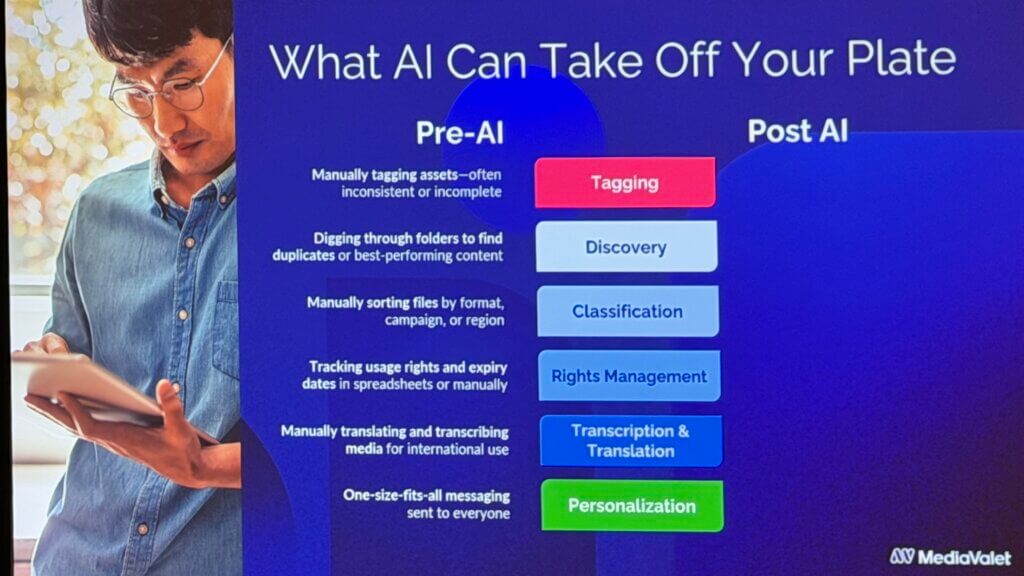 These are the exact areas where AI can help.
These are the exact areas where AI can help.- Tagging
- Discovery
- Classification
- Rights management
- Transcription and translation
- Personalization
- 70 percent of existing assets go unused because they can’t be found or trusted (Forrester).
- Create a brand guideline ecosystem, with:
- Auto-tagging
- Semantic and visual search
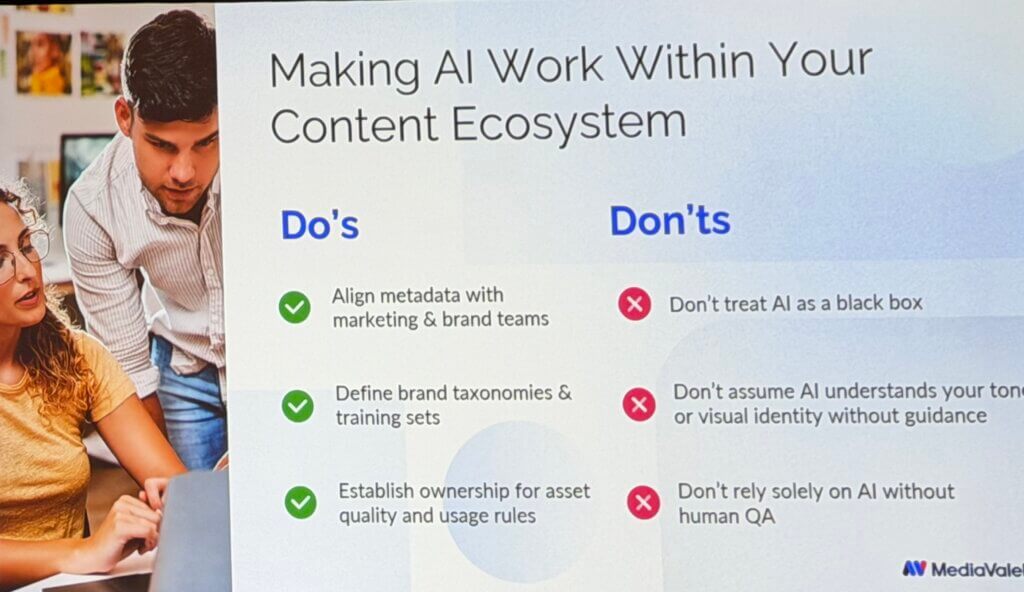 Rights automation
Rights automation- Predictive workflows
- Narrative search
- Start with AI metadata tagging. Everything builds from there.
- Don’t assume your AI understands your tone or visual identify without guidance.
- The future of brand management is not only faster, it’s a more intelligent and helpful ally that understands you and your business.
Earning Your Audience’s Applause: Late-Night TV Lessons in Customer-Winning Marketing
Presented by Joshua Cranmer, MILE6
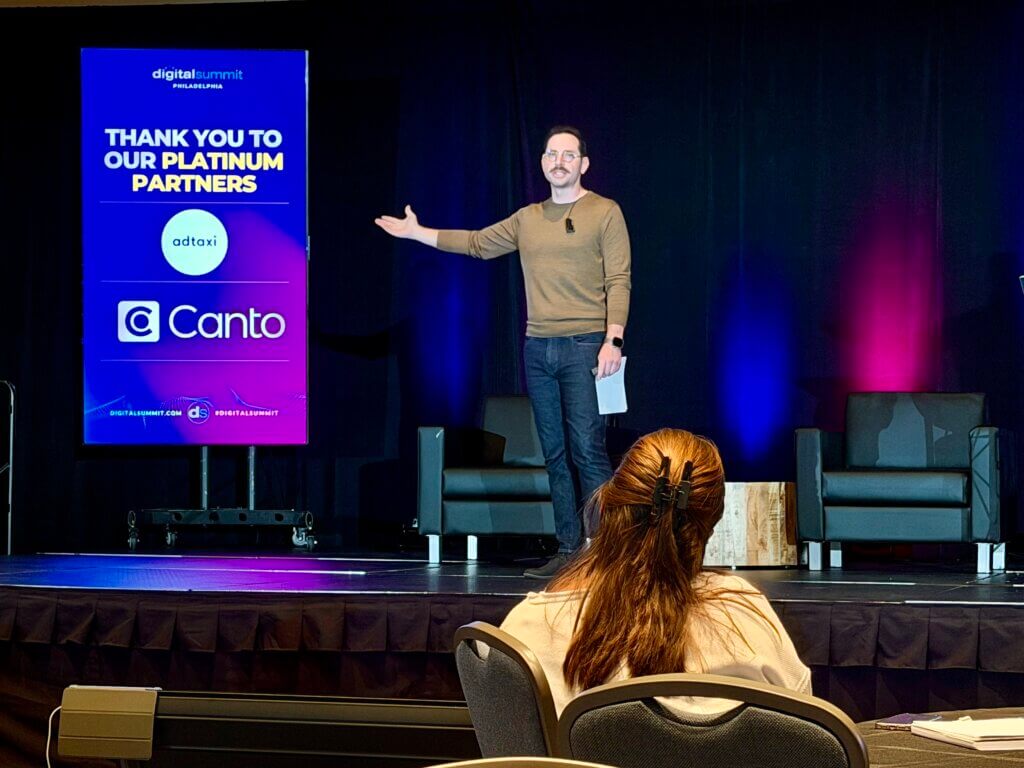
- Lackluster isn’t worth discussing. Luke warm messaging will get you ignored.
- Playing it safe is not the move if your job is to lead.
- “We’re the best,” “we’re industry defining” — empty, meaningless; avoid it.
- Build participation loops. Craig Furgeson couldn’t compete with other late night budgets, but he turned constraints into charm, he had audience members email and tweet to him and would engage them on the show. He overcame his lower budget by building connections.
- Advice on connecting with an audience in a new way:
- Publish “why we changed such and such” notes (be transparent about it, show a little bit of backstage).
- Show drafts
- Admit trade offs
- Credit user suggestions
- If all you can afford is authenticity, that means you can afford the most important factor.
- Escaping comparison is not a strategy, but earning a better comparison is.
- Show difference in service, speed, and outcomes.
- Built on [what] you trust, now faster to the [outcome] you want.
- Don’t let fear run the room.
- Trying to please everyone helps no one. Know who your audience isn’t.
- The Unique to Us test:
- What’s the specific belief or angle only we could credibly take?
- Define your archetype blend.
- Write three “we are not” statements.
- List “banned” words (leading, cost, maverick, etc.).
- Lead the heart. Then you can lead the head.
- Empathy exercise:
- What should the audience feel first?
- What should they know next?
- What should they do now?
- Options are plentiful. The win comes in how you frame it:
- How you label it.
- Where you place it.
- What expectations you set for it.
- Say what it is, why it exists, and who it’s for before you ask for attention.
- AI as it currently stands is not Artificial Intelligence. It’s Artificial Ingredients. It gives you pieces to help, but can’t intelligently create the whole on its own.
- Now more than ever, we can find quality in quantity.
- Final takeaways:
- Be clear
- Be empathetic
- Be unique
- Be interactive
- Be authentic
- Be bold
AI = Artful Interactions: Reimagining AI as a Catalyst for Progress
Presented by David Shing, aka Shingy, a futurist
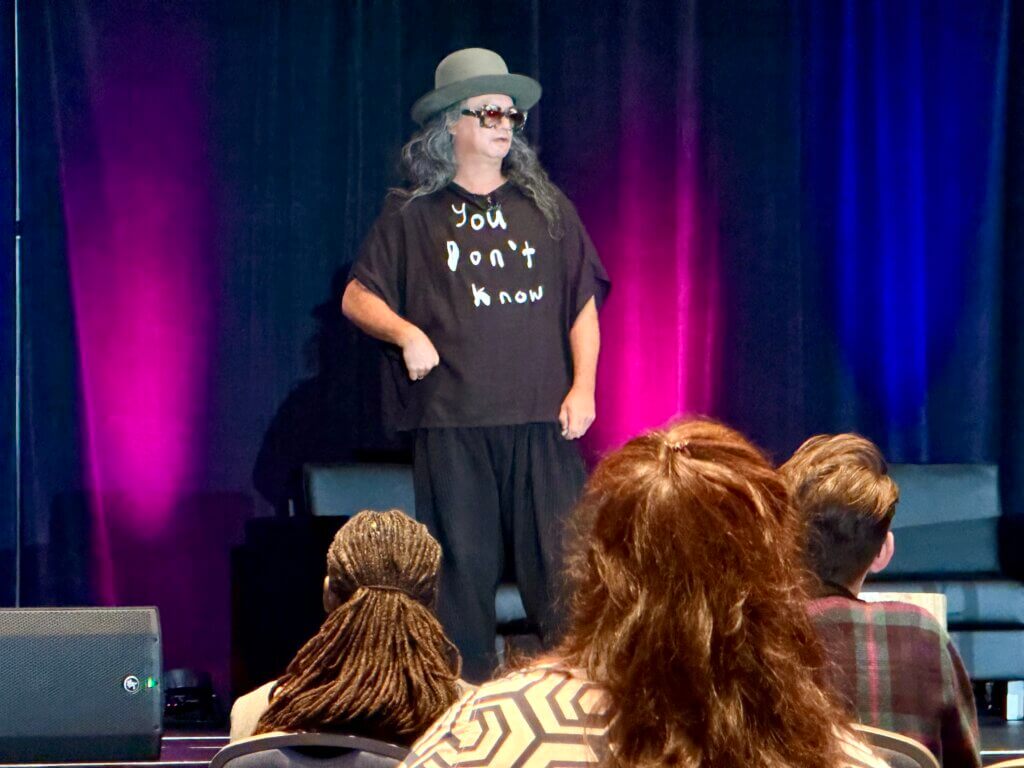
- Stop saying “omnichannel.” Think of a cycle instead.
- Stop trying to hold attention. Instead, try to hold intention.
- Retire the four P’s.
- 75% of purchase decisions are made based on emotion.
- When it comes to measuring, we need to go backwards, be old school:
- Impressions, awareness, word of mouth, referrals
- Focus on:
- Story
- Performance (BOGO, try for 90 days no obligation, etc.)
- Feel
- This futurists prediction for the future: creative will become a commodity, everything will look and read and feel the same, and we as creatives have a duty to remain inventive.
- Content is no longer king. Now it’s context.
- Perception is reality.
- Let AI do logic, let you do heart.
- Be foolish. Let the tools make weird, goofy, stupid stuff. Take risks that help you evolve.
- The secret ingredient to marketing success is surprise.
The Road to Omnichannel Marketing Success: Strategy, Systems and Smart Execution
Presented by Tyria Saul, Omaris Digital
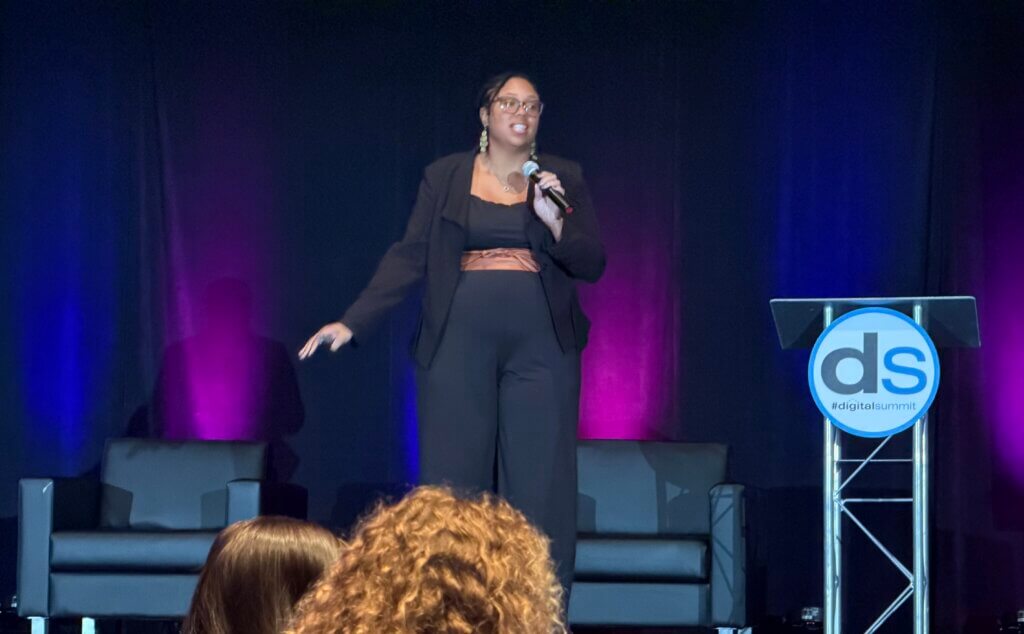
- Ignore that an earlier presenter challenged us to stop using the term “omnichannel.”
- AI is only as good as the information you put into it.
- It’s the same for your marketing tools — they’re only as powerful as the amount and accuracy of the data.
- How many companies today have AI included in their stack, but not in their workflow?
- Tools are bought with hope. But hope isn’t a strategy.
- Define your strategy before buying tech.
- Define your strategy before launching campaigns.
- Consider how iterative approaches can drive long-term adoption and success. It doesn’t have to be all things at once from the jump.
- Remember the concept of a most viable product (MVP).
- What channels are we using vs. what’s the goal state?
- What skillsets and resources are available to fulfill the desired plan?
- What’s the intended due date, then work backwards to understand what’s possible.
- Mismatched data between tools is. The. Worst.
- Someone on the team should be a clear owner of data.
- Standardize fields and rules.
- Create and implement clear and consistent data definitions.
- Try really hard for ecosystem-wide mapping.j
- Literally map it out:
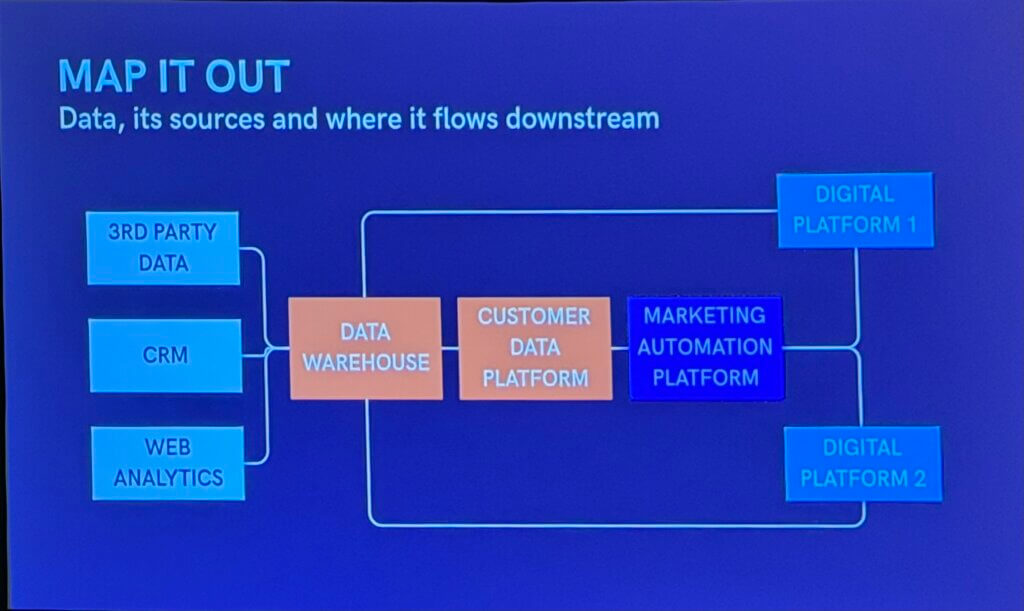
- Example of automated data processing: Every time something comes in with “pharma” as the industry, the system can convert it to “healthcare” so everything remains consistent.
- Bad data kills good campaigns — every time.
- Pitfalls to avoid to scale:
- Data transformation where unnecessary
- Lack of standardization
- Data integrations that are hard to change
- Too many fields
- Conduct a marketing capacity strategy: If every person has 5 reliable working hours a day, can your project needs fit into the amount of hours you have available?
- “I’m not a magician.” If your goal is 10 percent more leads, you may need 10 percent more budget. If you can only get 2 percent more budget, you may only be able to get 2 percent more leads.
- AI needs structure. Otherwise, it’s just chaos faster.
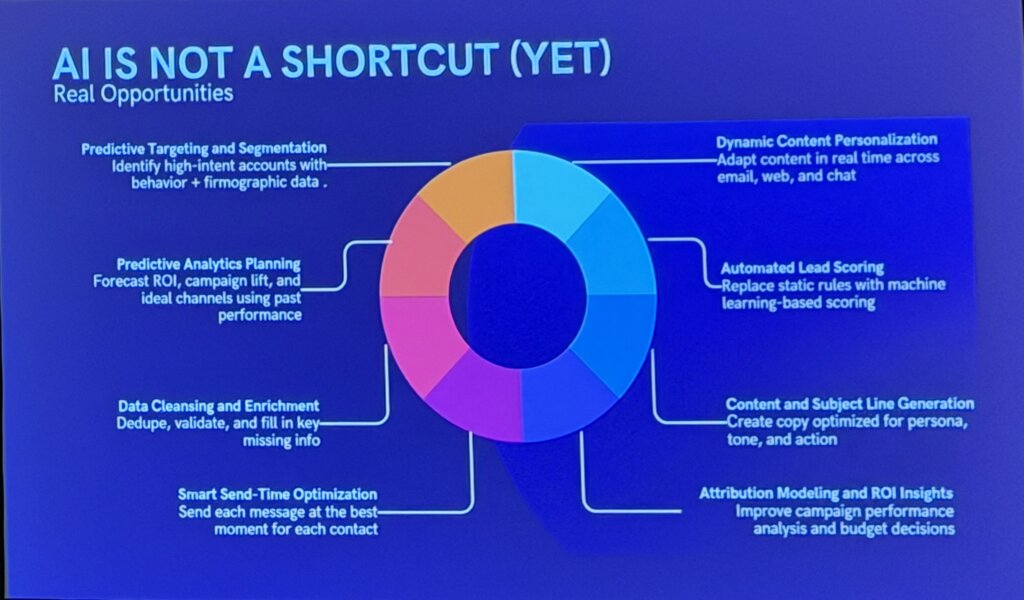
Not Your Parents’ Nat Geo: Pivoting from Reverence to Relevance
Presented by Aiman Ahmed and Danny Clemens from National Geographic
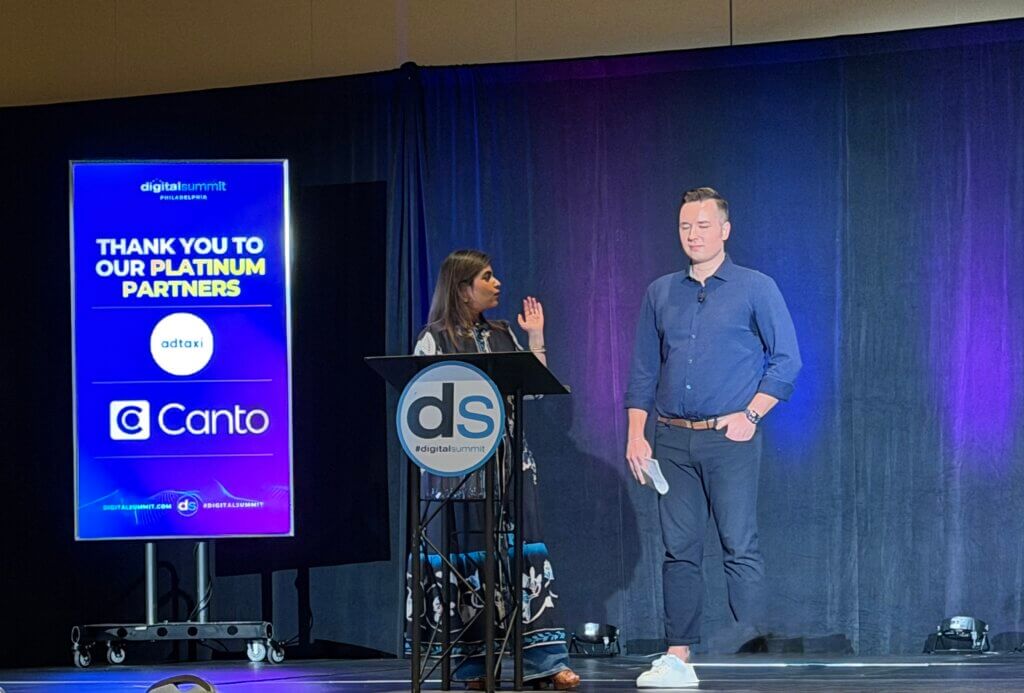
- Can you leverage the power of your brand without being weighed down by it?
- Nat Geo carries a ton of brand legacy, which can be wonderful, but can also be the ultimate golden handcuffs. The challenge is balancing the authenticity of their established brand with fresh alignment and innovation.
- You don’t have to be a global brand like Nat Geo; the goal is to connect in authentic spaces that resonate with what your brand represents.
- Authenticity:
- Identify purpose and core principles
- Define values
- Create behaviors
- Alignment:
- Guidelines
- Clear briefs
- Toolkits
- Innovation:
- Where do we show up?
- how do we show up?
- What’s next?
- Lean into what you’re good at, what you have access to. The most successful concept for Nat Geo? A series of 30 second videos of baby animals. Who wouldn’t want to engage with that?
- Come up with repeatable formats (like the 30 seconds of baby animals)
- Creating expectations also helps, like identifying from the jump that we’re only asking for 30 seconds of your time.
- Recycle and repurpose content. Your good content deserves better than a one-time post. Keep it alive.
- An absolute must is a consistent voice.
- They’re approach is to act like the biggest fan of Nat Geo shows. The excitement is infectious.
- They constantly respond to comments from other people’s content, in all social platforms, focusing on topics like travel that are connected to the brand. So they’re making themselves a part of the greater community.
- But they are not trying to be everything to everybody — they stay in their lane. Always on content strategy: meeting audiences where they are.
- Be comfortable with the idea that not everything is for everybody.
- Integrated marketing is key. They support their social efforts with paid efforts as well as partnerships. Everything working together at once to reinforce the story.
- Do not be afraid to pitch big ideas!
- Build consistency for audiences and create natural integrations of cross-brand talent across a variety of partners.
- Repeating this: develop repeatable formats (adding: that are specific to integrated marketing activations).
- When choosing creators, if the approach isn’t mindful and thoughtful, it can hurt more than help.
- Diversify reach and storytelling through strategic partnerships with content creators.
- Empower creatives with clear guidelines and toolkits to make content that resonates with their audiences. Give them very clear creative briefs and paramaters. Outside influences need to maintain their authenticity and yours.
- There is nothing more embarrassing than being late to a trend.
- For reputation management, connect with an agency that monitors all accounts at all times (presumably with AI). Don’t delete or hide the negative comments — let people express their opinions, and respond positively to it. This is a much more powerful way to build trust in the community.
- Frankly, it’s simple: Have access to the content and the content creators from Nat Geo’s owner — Disney — and you’re golden!
From Implementation to Impact: A Data-driven Approach to MarTech Adoption
Presented by Shannon Gregg, Cloud Adoption Solutions
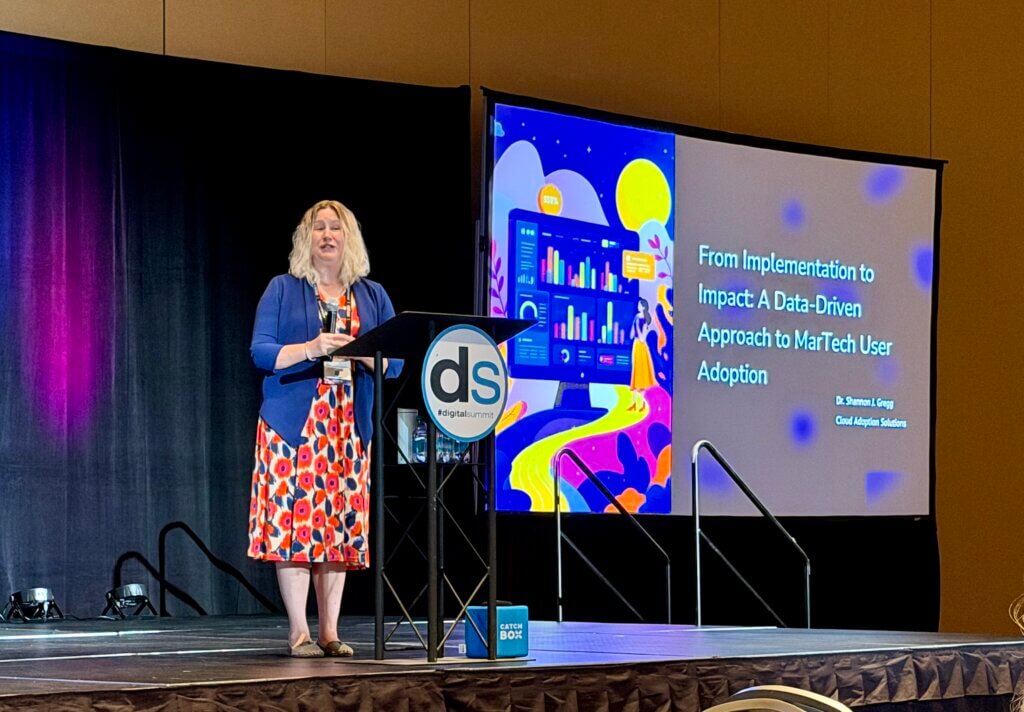
- The ‘Shelfware” Crisis — many marketing paying for many tools, much of which overlap others, and several that get no use.
- Focus was how you get your colleagues to adopt new tools and process.
- You have to make sure you explain why a change in process or tools is occurring.
- Human nature is to resist change.
- Use the concept of personas to apply to how you talk to them about why this new change benefits them.
- It’s okay to not work perfectly in the beginning. Get feedback to turn it into excellence.
- Adults only retain 10 percent of what you tell them in a training.
- Taking notes increases retention by 4x.
General Notes
- “Everyone’s freakin’ out about AI.”
- Multiple sessions made the case for doing away with personas.
Needle count:
Number of times I heard the phrase “moving the needle”:
12
Track count:
Number of times I heard the word “garbage” or “rubbish”:
8
Tissue count:
Number of times I heard the term “connective tissue”:
1


